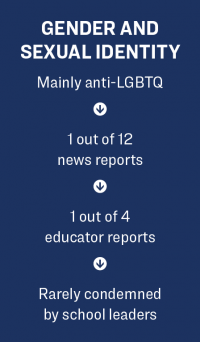
Incidents based on sexual orientation or gender identity comprised 25 percent of those reported by educators but just 10 percent of those reported in the news media.
Although we found a small number of incidents directed toward cisgender girls—including a fair amount of sexual innuendo—the overwhelming majority of incidents in this category targeted people who identify outside of cisgender or heterosexual identities. This form of harassment and bias starts in elementary school and ratchets up in middle and high school.
Anti-LGBTQ hate starts where it always has, with the use of “gay” and other adjectives as pejoratives.
LGBTQ teachers reported being harassed by students and colleagues. An educator in Texas told us that the LGBTQ community is “the most common marginalized/discriminated-against population. Using gay ... as an insult is done on a DAILY basis. Students use the word faggot as if it were no big deal—even though the county we live in houses a big population who identify as LGBTQ.”
What’s new is the harassment of the increasing number of students who identify as gender-fluid and transgender, by both classmates and teachers, many of whom refuse to use preferred pronouns or names.
The topic is fraught with political overtones, with students and sometimes educators insisting that there are only two genders.
While a few extreme cases of transphobia made news in 2018, educators reported that fewer than 2 percent of the gender and sexual identity-based hate incidents they witnessed received media coverage—suggesting that anti-LGBTQ bias doesn’t create much outrage in many communities.
Hate based on gender and sexual identity, however, was among the most likely to lead administrators to provide support for marginalized students and to prompt school leaders to denounce the act and reaffirm the school’s values.
"Not going to lie. You freak me out."
—Said to a transgender sophomore by assistant principal (Media report, West Virginia)